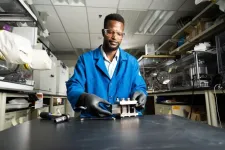Better phosphorus use can ensure its stocks last more than 500 years and boost global food production - new evidence shows
More efficient use of phosphorus could see limited stocks of the important fertiliser last more than 500 years and boost global food production to feed growing populations.
2024-03-25
(Press-News.org)
More efficient use of phosphorus could see limited stocks of the important fertiliser last more than 500 years and boost global food production to feed growing populations.
But these benefits will only happen if countries are less wasteful with how they use phosphorus, a study published today in Nature Food shows.
Around 30-40 per cent of farm soils have over-applications of phosphorus, with European and North American countries over-applying the most.
The global population is due to hit nearly 10 billion by 2050 and it is estimated that to feed this increased population a further 500 million hectares of arable land will be needed – unless phosphorus can be more efficiently used to boost and maintain crop yields.
Listed as a critical raw material by the European Union, and recently a topic of discussion by the United Nations Environment Assembly, globally 20,500 kilotons of phosphorus are applied to agricultural soils each year as fertiliser.
Concerns have been raised about its limited supply and loss to freshwater where it can degrade water quality. Phosphorus predominantly comes from mining phosphate rock sources, of which there are only a relatively small number of sources located in countries like Morocco and Russia.
Previous estimates of how much phosphorus we have left globally have varied greatly from between 30 to over 300 years. These prior estimates were based on current wasteful practices continuing and contained a lot of uncertainty.
This latest research, looking at global phosphorus use and soil concentrations, by scientists at Lancaster University in the UK as well as AgResearch and Lincoln University in New Zealand, examined concentrations of phosphorus in farm soils across the globe for optimum growth of 28 major food crops from wheat and maize to rice and apples. The research revealed soils that did not contain enough phosphorus, and soils that contain concentrations higher than plants need for optimal growth.
Their findings shed new light on the amounts of phosphorus available in soils and needed as fertilisers and reveal that phosphorus reserves could last for up to 531 years if we use it more efficiently and equitably – that’s 77 years longer than if we stick with current practices.
Professor Phil Haygarth of Lancaster University and co-author of the paper said: “Phosphorus is an essential fertiliser that drives food production on farms around the world. It’s the ‘energy’ of agriculture that drives our food systems, but we need to manage our supplies carefully.
“We need to seek ways to be more efficient and sustainable with its use and our study shows that there’s considerable potential to improve the efficiency of how we use phosphorus fertilisers. We show it’s possible to optimise global food production without accelerating the depletion of precious and finite global phosphorus fertiliser reserves.
“We are unlikely to run out of phosphorus in the next 500 years, but only if we apply as much as needed to produce optimal crop yields and stop wasteful over-applications.”
The research team calculated 10,556 kt of phosphorus is wasted each year through over-application with much of that dominated by wheat and grassland in Europe and maize and rice in Asia.
Professor Richard McDowell of Lincoln University and AgResearch New Zealand and lead author of the study said: “Many farmers over-apply phosphorus to bank it in the soil. However, only a fraction of soil phosphorus can be used by plants. Adjusting applications to sustain the levels that plans need to produce optimal yields negates the need for phosphorus being wasted. If there are excessive levels in soil that plants can’t use, phosphorus can potentially be lost to water, which risks causing water quality problems like eutrophication.”
But it is not all about reductions. The scientists, using data for farmland globally, also calculated that around the world nearly three quarters of farmed soils are in phosphorus deficit - with phosphorus deficits being most acute in Asian countries such as India. As a result, the researchers calculate that globally there needs to be an application of almost 57,000 kt of phosphorus to alleviate those soils in deficit to boost crop yields.
They then calculated that 17,500 kt of phosphorus is needed each year to maintain optimum soil phosphorus concentrations. This would result in a global reduction in the demand for phosphorus by around 3,000 kt annually.
Professor McDowell said: “The science is clear, but to use phosphorus efficiently and extend supplies, governments need to collaborate to make policy that promote phosphorus use only where needed. That will involve balancing distributions of phosphorus for optimal crop growth and reducing subsidies that sustain overuse of phosphorus and likely cause water quality problems.”
The findings are outlined in the paper ‘Phosphorus applications adjusted to optimal crop yields can help sustain global phosphorus reserves’ published by Nature Food.
The paper’s authors are Professor Richard McDowell and Peter Pletnyakov of Lincoln University and AgResearch, and Professor Phil Haygarth of Lancaster University. Professor McDowell was funded by New Zealand’s Our Land and Water National Science Challenge.
END
ELSE PRESS RELEASES FROM THIS DATE:
2024-03-25
RICHLAND, Wash.— A commonplace chemical used in water treatment facilities has been repurposed for large-scale energy storage in a new battery design by researchers at the Department of Energy’s Pacific Northwest National Laboratory. The design provides a pathway to a safe, economical, water-based, flow battery made with Earth-abundant materials. It provides another pathway in the quest to incorporate intermittent energy sources such as wind and solar energy into the nation’s electric grid.
The researchers report ...
2024-03-25
Scientists from The Australian National University (ANU) have discovered a gene mutation is responsible for causing psoriasis – a chronic inflammatory skin disease that causes patients to develop red, scaly and itchy patches across their body.
According to ANU researcher Dr Chelisa Cardinez, if two copies of this mutated gene (known as IKBKB) are present, patients with psoriasis may go on to develop psoriatic arthritis, leaving them with joint pain, stiffness and swelling. Thanks to the world-first discovery from ANU, scientists now know what causes the progression from a skin-only disease to a skin and joint disease.
It’s hoped the findings will lead ...
2024-03-25
In the United States, community health centers (CHCs) mainly serve historically marginalized populations. New research reveals that both before and during the COVID-19 pandemic, females receiving care at rural CHCs were less likely to be up to date with cervical cancer screening than those in urban CHCs. Factors associated with these differences included the proportion of patients with limited English proficiency and low income, as well as area-level unemployment and primary care physician density. The findings are ...
2024-03-25
ANN ARBOR, Mich. – Many parents struggle deciding whether their middle or high school aged child should stay home from school if they don’t feel well, a new national poll suggests.
Among top factors: how their adolescent or teen is behaving due to symptoms and if they can get through a school day, the risk that they’re contagious and whether the student will miss a test, presentation or after school activity.
One in five parents also consider if their child needs a mental health day, according to the University of Michigan ...
2024-03-25
Physicians in Canada, especially male physicians, are working fewer hours than they did 3 decades ago, and these long-term trends must be considered in workforce planning, according to new research in CMAJ (Canadian Medical Association Journal) https://www.cmaj.ca/lookup/doi/10.1503/cmaj.231166.
"Canadian physicians' work hours, crucial for health care access and planning, have seen a long-term decline, especially among male and married physicians, suggesting a shift towards better work–life balance," said Dr. Boris Kralj, Department of Economics, Centre for Health Economics & Policy Analysis, McMaster University, Hamilton, Ontario.
Using ...
2024-03-25
Drugs, both legal and illegal, cause millions of cases of severe intoxication every year, leading to health complications and even fatalities. Often, they are also implicated in violent and sexual harassment crimes, as well as accidents. Obtaining detailed information about the drugs consumed by a criminal or victim is often challenging. Forensic professionals rely on drug screening techniques performed on biological samples, such as blood or saliva, to gather crucial evidence.
Today, various types of practical drug screening methods exist, each with their own unique advantages ...
2024-03-25
Hundreds of studies are published each year on attention deficit hyperactivity disorder (ADHD), but more work is needed to ensure those findings improve lives.
With input from expert stakeholders across the field, researchers at the Southern California Evidence Review Center, part of the Keck School of Medicine of USC, have synthesized the latest insights so that they can ultimately inform clinical practice. Broadly, they found that both medications and psychosocial treatments work for treating ADHD and that children with the condition can and do get better.
“We have more research than ever on ADHD, but we need ...
2024-03-25
Researchers at the University of Waterloo's Institute for Quantum Computing (IQC) have brought together two Nobel prize-winning research concepts to advance the field of quantum communication.
Scientists can now efficiently produce nearly perfect entangled photon pairs from quantum dot sources.
Entangled photons are particles of light that remain connected, even across large distances, and the 2022 Nobel Prize in Physics recognized experiments on this topic. Combining entanglement with quantum dots, a technology recognized with the Nobel Prize in Chemistry in 2023, the IQC research team aimed to optimize the ...
2024-03-25
By exploring attitudes in the USA, UK, Italy, South Africa, Mexico, and Poland – countries with different economies, cultures and political regimes (past and present) – the paper shows that, in all countries, right- compared to left-wing supporters evaluated the past more positively.
The data reveal that, in part, this occurs because right-wing supporters are more nostalgic about tradition. While the right looked more favourably to the past, in the USA and Poland (and potentially in the UK too), the left was more ...
2024-03-25
Scientists have successfully carried out pioneering fecal microbiota transplantations on Navy bottlenose dolphins that showed signs of gastrointestinal disease.
One dolphin in particular who was outwardly ill was able to be taken off medication during the treatment course, with his appetite and energy returning to normal, according to the team at the National Marine Mammal Foundation.
The project was carried out jointly between the NMMF, the U.S. Navy Marine Mammal Program and the Gilbert Lab at UCSD School of Medicine and Scripps Institution of Oceanography, and its findings were published in the Journal of ...
LAST 30 PRESS RELEASES:
[Press-News.org] Better phosphorus use can ensure its stocks last more than 500 years and boost global food production - new evidence shows
More efficient use of phosphorus could see limited stocks of the important fertiliser last more than 500 years and boost global food production to feed growing populations.





